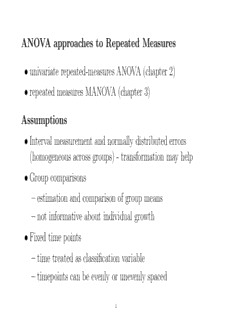
ANOVA approaches to Repeated Measures • univariate repeated-measures ANOVA PDF
Preview ANOVA approaches to Repeated Measures • univariate repeated-measures ANOVA
ANOVA approaches to Repeated Measures • univariate repeated-measures ANOVA (chapter 2) • repeated measures MANOVA (chapter 3) Assumptions • Interval measurement and normally distributed errors (homogeneous across groups) - transformation may help • Group comparisons – estimation and comparison of group means – not informative about individual growth • Fixed time points – time treated as classification variable – timepoints can be evenly or unevenly spaced 1 • Better suited for short-term or moderate change esp. true for trend or growth-curve analysis • LS techniques adversely affected by outliers • Missing data – ANOVA can handle some - unbalanced ANOVA – MANOVA can’t handle any • Variance-covariance structure for y i – compound symmetry for ANOVA – unstructured for MANOVA 2 Univariate Repeated Measures ANOVA One-sample case: randomized block ANOVA y = µ + π + τ + e (i = 1, . . . , N ; j = 1, . . . , n) ij i j ij • µ = grand mean • π = individual difference component for subject i i (constant over time) • τ = effect of time - same for all subjects j • e = error for subject i and time j ij Random components 2 • π ∼ N(0, σ ) subjects random; between-subjects variance i π 2 • e ∼ N(0, σ ) within-subjects variance ij e 3 Data layout timepoint subject 1 2 . . . n 1 y y . . . y 11 12 1n 2 y y . . . y 21 22 2n . . . . . . . . . . . . . . N y y . . . y N1 N2 Nn • one observation per cell • similar to randomized block design with subject as block • identical to paired-t test when n = 2 4 Model assumptions n τ = 0 (n − 1 df for Time) X j j=1 E(y ) = µ + τ ij j 2 2 V (y ) = V (µ + τ + π + e ) = σ + σ ij j i ij π e 0 C(y , y ) = 0 for i 6= i (different subjects) ij i0j 2 0 C(y , y ) = σ for j 6= j (same subject) ij ij0 π 5 Intraclass correlation 2 σ π Corr(y , y ) = ij ij0 2 2 σ + σ π e • same correlation for all longitudinal pairs (average correlation of y from any two timepoints) • ranges from 0 to 1, so more like a proportion of variance • proportion of total variance that is attributable to subjects (that is not accounted for by Time) 6 Compound symmetry structure of variance-covariance matrix 2 2 2 2 2 σ + σ σ σ . . . σ e π π π π 2 2 2 2 2 σ σ + σ σ . . . σ π e π π π Σ = . . . . . . . . . . . . . . . y i 2 2 2 2 2 σ . . . σ σ + σ σ π π e π π 2 2 2 2 2 σ σ . . . σ σ + σ π π π e π 2 2 • variance homogeneous across time: σ + σ e π 2 • covariances homogenous across time: σ π 2 2 2 correlation = σ /(σ + σ ) π e π 7 Not too realistic • variances often change over time: increase is common in clinical trials (subjects more similar at start of trial) • covariances close in time usually greater than covariances distil in time ⇒ test of variance-covariance structure is necessary for the validity of significance tests (more on this later) 8 9 ANOVA table: subjects random and time fixed (balanced) Source df SS MS E(MS) SS Subjects N − 1 SS = n N (y¯ − y¯ )2 S σ2 + nσ2 S Pi=1 i. .. N−1 e π SS Time n − 1 SS = N n (y¯ − y¯ )2 T σ2 + N (τ − τ )2 T Pj=1 .j .. n−1 e P j . SS Residual (N − 1) SS = N n (y R σ2 R Pi=1 Pj=1 ij (N−1)(n−1) e ×(n − 1) −y¯ − y¯ + y¯ )2 i. .j .. total Nn − 1 SS = N n (y − y¯ )2 y Pi=1 Pj=1 ij .. • y¯ = grand mean (averaged over time and subjects) .. • y¯ = subject mean (i = 1, . . . , N) i. • y¯ = timepoint mean (j = 1, . . . , n) .j 10
Description: